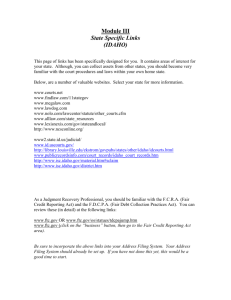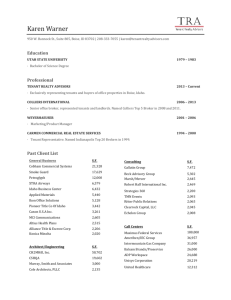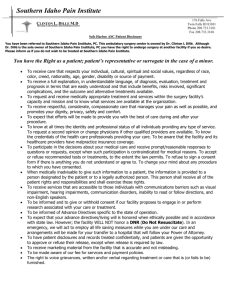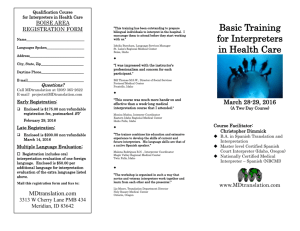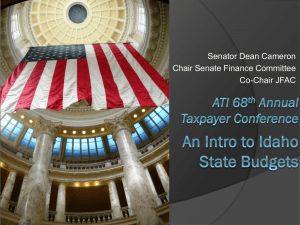NLI INA Legislative Update February 5 2016
advertisement
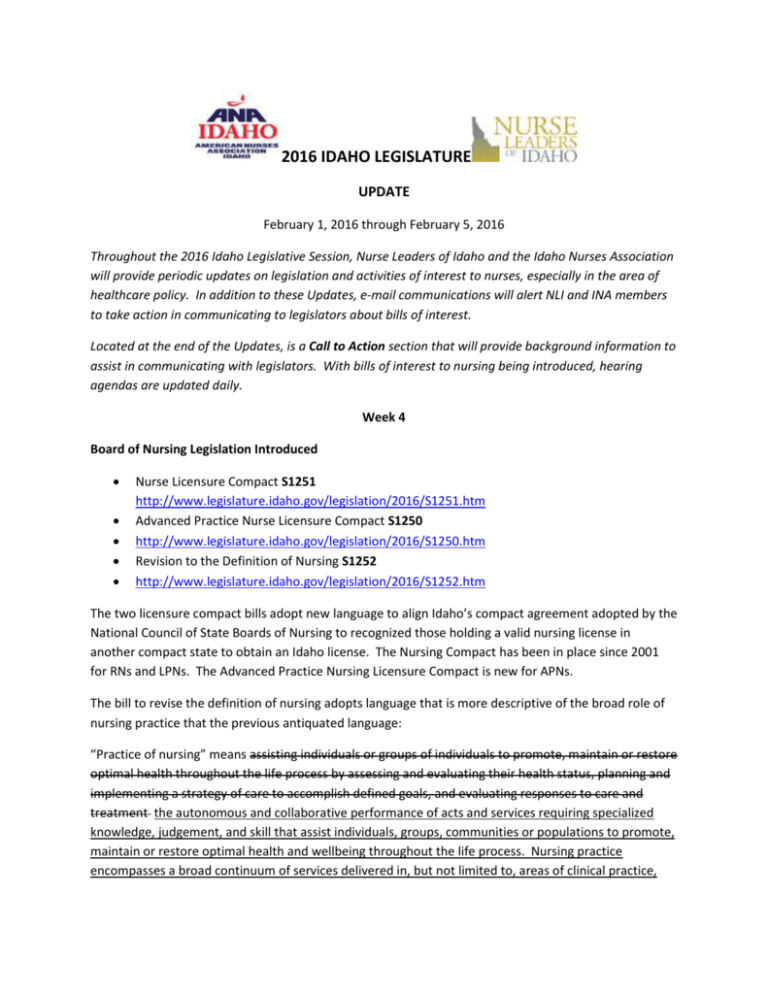
2016 IDAHO LEGISLATURE UPDATE February 1, 2016 through February 5, 2016 Throughout the 2016 Idaho Legislative Session, Nurse Leaders of Idaho and the Idaho Nurses Association will provide periodic updates on legislation and activities of interest to nurses, especially in the area of healthcare policy. In addition to these Updates, e-mail communications will alert NLI and INA members to take action in communicating to legislators about bills of interest. Located at the end of the Updates, is a Call to Action section that will provide background information to assist in communicating with legislators. With bills of interest to nursing being introduced, hearing agendas are updated daily. Week 4 Board of Nursing Legislation Introduced Nurse Licensure Compact S1251 http://www.legislature.idaho.gov/legislation/2016/S1251.htm Advanced Practice Nurse Licensure Compact S1250 http://www.legislature.idaho.gov/legislation/2016/S1250.htm Revision to the Definition of Nursing S1252 http://www.legislature.idaho.gov/legislation/2016/S1252.htm The two licensure compact bills adopt new language to align Idaho’s compact agreement adopted by the National Council of State Boards of Nursing to recognized those holding a valid nursing license in another compact state to obtain an Idaho license. The Nursing Compact has been in place since 2001 for RNs and LPNs. The Advanced Practice Nursing Licensure Compact is new for APNs. The bill to revise the definition of nursing adopts language that is more descriptive of the broad role of nursing practice that the previous antiquated language: “Practice of nursing” means assisting individuals or groups of individuals to promote, maintain or restore optimal health throughout the life process by assessing and evaluating their health status, planning and implementing a strategy of care to accomplish defined goals, and evaluating responses to care and treatment the autonomous and collaborative performance of acts and services requiring specialized knowledge, judgement, and skill that assist individuals, groups, communities or populations to promote, maintain or restore optimal health and wellbeing throughout the life process. Nursing practice encompasses a broad continuum of services delivered in, but not limited to, areas of clinical practice, education, administration, research, and public and volunteer services. Nursing practice occurs at the physical location of the recipient. As of Friday, hearings on the three nursing bills have not been assigned. Governor’s Office Monday Briefing – PCAP The focus of the Governor’s briefing on Monday was his Primary Care Access Program (PCAP) to address those in the gap between Medicaid and subsidized private health insurance under the Healthcare Exchange. The Governor’s staff and the Department of Health and Welfare have been working with legislators and the lobbyists to support their alternative to Medicaid expansion. Two previous proposals for Medicaid expansion have failed to get hearings over the past two years. The Governor’s proposal has opened the discussion in the legislature making it more likely that a solution to address the gap population will be adopted this session. PCAP provides for primary care, preventive services, acute care, clinic based behavioral health (22% of patients have behavioral health issues), and basic X-ray, laboratory and drug coverage aimed at maintenance for chronic illness. PCAP does not provide for emergency, hospitalization or specialty care which would continue to be covered through county indigent programs and the state’s catastrophic fund. In utilizing the Medical Home Model under PCAP, the objective is to provide ongoing preventive and primary care to avoid costly emergency care and hospitalization. PCAP would be entirely funded by the state. House leadership is exploring various funding sources including the tobacco tax, savings from the catastrophic healthcare fund and the millennium fund which was created through the tobacco settlement. The program would expire (sunset) in five years unless renewed. The PCAP bill has yet to be introduced. Medicaid Expansion – Senator Schmidt Senator Dan Schmidt, a physician from Moscow, introduced two bills to expand Medicaid. Medicaid expansion was a component of the federal Affordable Care Act that provides federal funding for comprehensive health insurance coverage, including hospital and specialty care, for those in the gap between Medicaid eligibility and health insurance subsidy. One of his proposals would enact the “Healthy Idaho Plan” that would expand Medicaid for those up to the federal poverty level ($981/month for one/$1,328/month for two), then use federal Medicaid funds to purchase private health insurance from the Health Insurance Exchange (S1205) for those making up to 138% of poverty. Last year, 54,000 applied under the health insurance exchange but were turned away because they made too little to qualify for coverage. Senator Schmidt’s other proposal is to expand full traditional Medicaid (S1204) for those below 138% of poverty, the level at which subsidies under the Affordable Care Act kick in. Both proposals would be funded by the federal government, saving the $30M the Governor is proposing for PCAP. The Senate Health and Welfare Committee held a hearing Tuesday afternoon to hear testimony on Senator Schmidt’s bills. There were approximately 200 who attended with overflow into three conference rooms. Testimony overwhelmingly supported the Healthy Idaho Plan. The Idaho Freedom Foundation testified against the bills noting the submission to federal control and contribution to the federal deficit. The Gap 78,000 adults 19-64 78,000 Idaho adults (19-64) are in the gap between Medicaid eligibility (eligibility limit for Medicaid is under $350/month for household of 2) and health insurance subsidy under the federal Affordable Care Act (income below 138% federal poverty line). They are left without health insurance coverage. Of the 78,000, 50,000 currently receive services from federally supported Community Health Centers and Rural Health Clinics. Here is an overview of the four options being considered: Four Options 1) Full Traditional Medicaid Expansion – Medicaid Redesign Work Group Recommendation 2012 Extend full Medicaid coverage to 138% poverty Funded 100% by federal government (2016), then 90/10 share Current Medicaid funding 70/30 share Resistance to federal control – once accepted, can state opt out? Will federal funding decline – no guarantee of continued federal funding Contributes further to $19T federal debt 2) Healthy Idaho Plan – hybrid Governor Reconvened Workgroup Recommendation 2014 Extend traditional Medicaid up to 100% poverty Utilize Medical Home Model for care management and coordination Provides comprehensive healthcare coverage including hospitalization Push those between 100% and 138% of poverty into the Health Insurance Exchange to acquire private health coverage subsidized by the plan Funded 100% (2016) initially by federal government, then 90/10 Engages personal responsibility Relies on private coverage through Health Insurance Exchange for those above 138% No guarantee of continuing federal funding Supported by INA, IMA, IHA Concern over shortage of providers to meet added need 3) Primary Care Access Plan (PCAP) - Governor’s proposal 2016 Developed by Department of Health & Welfare Unique Idaho plan Provides primary care only – includes limited drug formulary, lab, x-Ray Focus on prevention, ongoing care coordination, chronic illness management, compliance No specialty coverage, no hospitalization Utilizes medical home model – engages personal responsibility Not insurance. State pays $32/person/month to manage care. Patient pays premium $4 $25/month sliding scale State cost $30M – considered funding sources include tobacco tax, CAT fund savings ($29M), Millennium fund Continues County indigent funds (first $11,000), and state Catastrophic (CAT) fund to cover necessary specialty and inpatient care Total Idaho control – avoids federal intrusion – unique Idaho Plan No federal oversight No reliance on federal funds, No contribution to federal debt 5-year sunset provision Not comprehensive coverage - inadequate coverage Supported by INA as start toward coverage for gap. Other associations on wait and see 4) No Change – continue the Gap Limited Access Continues reliance on County indigent funds Continues state CAT fund 50,000 of 78,000 in gap being served by Community Health Centers and Rural Health Clinics now FQHC and Rural Health Clinics now receiving federal funding to cover poor and uninsured CALL TO ACTION Watch your e-mail Between Monday morning and Tuesday afternoon’s hearing, there was a flurry of activity around Medicaid Expansion. Organizations were lining up support for the Healthy Idaho Plan. The INA Legislative Committee had expressed support for the Healthy Idaho Plan as the best option, but are also supporting the Governor’s PCAP proposal if the Healthy Idaho Plan fails. Monday afternoon was a scramble to issue an e-mail Call to Action with a link to members of the Senate Health and Welfare Committee so nurses could express support for the bill. Senator Heider, Chair of the Committee, commented on the number of e-mails he had received. It is an effective tool to communicate with your legislators; so please watch your e-mail. As you hear of issues or have question about the legislature, please let Mike know by e-mail at mcgraneconsulting@gmail.com.
